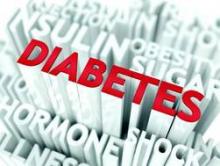BOSTON – Rural African-American women with poorly controlled type 2 diabetes saw significant improvements in glycemic control when their disease-related distress levels dropped.
The findings, from a randomized, controlled trial of 150 women, add to a growing body of evidence that diabetes-related emotional distress – which can include concerns related to disease management, a fear of becoming sicker, and a sense of being isolated or overwhelmed as a result of the disease – bears on clinical outcomes in type 2 diabetes, particularly HbA1c.
A validated diabetes distress score was introduced a decade ago for use in clinical research (Diabetes Care 2005;28:626-31), and last year investigators in San Francisco showed that people with lower stress related to their diabetic care regimens had significantly lower HbA1c and better medication adherence (Diabetes Care 2014;37:617-24).
At the annual scientific sessions of the American Diabetes Association, Doyle Cummings, Pharm.D., of East Carolina University in Greenville, N.C., presented data from the EMPOWER study, a prospective, randomized clinical trial among rural African-American women in North Carolina. Dr. Cummings reported a similar association between distress and HbA1c.
The EMPOWER study randomized 150 mostly low-income African-American women with uncontrolled type 2 diabetes (mean age 55, mean 10.9 years with diabetes, and mean HbA1c of 9.1) to an in-person or phone-delivered lifestyle intervention delivered by community health workers or mailed written advice. The in-person or phone-delivered intervention involved 16 sessions of training in nutrition, physical activity, and self-monitoring, emphasizing small and incremental changes.
The investigators looked at weight and HbA1c at 12 months, compared with baseline in both groups, and found modest improvements for both measures in the active intervention group as predicted and significantly greater reductions in the subgroup on oral medications only.
Distress levels at baseline and 12 months were among the study’s secondary outcomes, along with measures of medication adherence, self-efficacy, and self-care behaviors.
Dr. Cummings told the conference that the investigators were surprised to find “no substantial difference in the decline in distress levels between treatment groups. The folks in the intervention and control groups had fairly similar reductions in mean distress scores at 12 months,” he said, with two-thirds of subjects reporting some degree of decline.
The investigators combined data from the two groups to examine distress levels and other outcomes. “And we found that HbA1c dropped much more substantially in those in whom distress was lowered, compared to those with whom distress was unchanged or increased,” Dr. Cummings said. “Medication adherence, self-care behaviors, and diabetes empowerment and self-efficacy were all substantially improved in the group with lower levels of distress at the end of the trial.”
But even after controlling for these other covariables, distress level remained a significant correlate of change in HbA1c (P = .04).
“Why does this happen? The truth is, we don’t know,” Dr. Cummings said.
Changes in HbA1c may be related to factors such as self-care behaviors and adherence, he acknowledged, “but quite frankly there could be other mechanisms less explored that may help to explain this relationship. So clearly we need additional research. What this does show is that lowering distress seems to be a valuable strategy in folks like this with elevated HbA1c levels.”
Dr. Cummings spoke about some of the daily challenges facing the women in the study. “We’re surprised at the number of these women caring for children, grandchildren, and other members of their families, often while working, and yet not finding time to care for themselves. It is clearly an important cultural phenomenon that we need to understand better.”
Also at the conference, Dr. Cummings and colleagues presented a separate, striking set of findings on distress and cardiovascular outcomes using data from a different source: the national Reasons for Geographic And Racial Differences in Stroke (REGARDS) cohort study.
Dr. Cummings and colleagues compared the relationship between baseline depressive symptoms and/or distress and incident stroke, acute coronary heart disease (CHD), and CV death in more than 4,000 black and white adults 45 and older with diabetes, and nearly 18,000 subjects without diabetes, followed up for more than 5 years.
Subjects with diabetes were more likely to have either depressive symptoms or distress (26.7% vs. 23.2%, P < .001) or both (10.1% vs. 6.2%, P < .001), compared with those without diabetes.
In models adjusted for sociodemographics, medical conditions, health behaviors, and physiologic measures, either distress or depressive symptoms at baseline was associated with increased risk for stroke (adjusted hazard ratio 1.54; 95% confidence interval, 1.04-2.27) and cardiovascular (CV) death (aHR, 1.61; 95% CI, 1.14-2.29) among subjects with diabetes. None of these associations were significant for people without diabetes.


